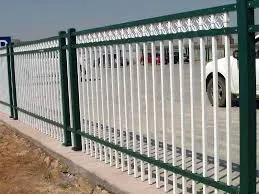
Okt . 15, 2024 13:11 Back to list
Comparing Metal Sheet and Concrete Fence Options for Your Property
Metal Sheet vs. Concrete Fence Products A Comprehensive Comparison
When it comes to fencing options, two popular materials that homeowners and businesses often consider are metal sheets and concrete. Both have unique benefits and drawbacks, making the choice nuanced and contingent upon various factors such as durability, cost, maintenance, aesthetics, and environmental impact. This article seeks to explore these two options in-depth to aid in informed decision-making.
Durability
Durability is often a primary consideration when selecting fencing materials. Metal sheets, particularly those made of galvanized steel or aluminum, offer significant resistance to rust, corrosion, and damage from pests. They can withstand high winds and adverse weather conditions, making them a popular choice in areas prone to storms or heavy rainfall. However, while metal sheets are durable, they can dent or warp under extreme impact.
On the other hand, concrete fences are known for their incredible strength and longevity. With proper installation, they can last for decades with minimal wear and tear. Unlike metal, concrete isn't susceptible to rust, corrosion, or pests. However, it can crack under extreme conditions or if not installed correctly, leading to costly repairs.
Cost
When considering cost, metal sheets often come out ahead as a more budget-friendly option, both in terms of material and installation expenses. The initial investment for metal fencing is generally lower, and the lightweight nature of metal sheets can lead to reduced labor costs during installation.
Concrete fences typically require a higher upfront investment due to the cost of materials and the need for specialized labor. The substantial weight of concrete also necessitates more robust foundation work, further increasing installation expenses. However, when evaluating long-term costs, including maintenance and potential repairs, concrete fences may represent a better investment, given their extended lifespan.
Maintenance
Metal fences require some maintenance to prolong their life span. Depending on the type of metal used, regular treatments with anti-corrosive coatings or paint might be necessary, especially in harsher climates. Also, metal can be prone to scratches and dents, which may need repainting or repair to maintain aesthetic appeal.
metal sheet vs concret fence products

In contrast, concrete fences are generally low maintenance. They do not need regular painting or chemical treatments, and occasional cleaning with water is usually sufficient to keep them looking their best. However, any cracks or damage to the concrete may require professional repair to prevent further deterioration.
Aesthetics
The aesthetic appeal of metal sheets versus concrete also plays a significant role in the decision-making process. Metal sheets can offer a modern, industrial look that may complement contemporary architecture. They are available in various colors and finishes, allowing for customization.
Concrete, while perhaps less visually versatile, offers a solid and substantial appearance. It can be formed or textured to mimic various styles, including stone or brick. Additionally, concrete can be painted or stained to improve its aesthetic appeal, although this can lead to increased maintenance.
Environmental Impact
In assessing environmental factors, metal sheets can be recycled at the end of their lifecycle, reducing their overall impact. However, the manufacturing process for metal products can be energy-intensive.
On the flip side, concrete is made from abundant natural resources, but its production is also energy-intensive, emitting significant amounts of carbon dioxide. However, once installed, concrete fences can be highly efficient, providing energy savings through thermal insulation.
Conclusion
Ultimately, the choice between metal sheet and concrete fence products depends on individual needs and preferences. If immediate cost and modern aesthetics are critical factors, metal sheets may be the way to go. However, for those prioritizing durability and low maintenance in the long run, a concrete fence might be the better investment. Understanding these variables can help homeowners and businesses make the right choice for their fencing needs.
-
High-Quality Metal Picket Fence - Durable, Stylish & Customizable Solutions
NewsJul.08,2025
-
358 Anti-Climb Fence High Security Mesh, Durable & Cost-Effective Solutions
NewsJul.08,2025
-
High-Quality Chain Link Fence Parts Reliable Suppliers & Factory Prices
NewsJul.07,2025
-
Clear View Fence Anti Climb - High Security Fencing Factory & Suppliers Quotes
NewsJul.07,2025
-
Temporary Fence Business for Sale Factory Direct Suppliers & Best Quotes
NewsJul.06,2025
-
High-Quality Temporary Fence Fittings - Trusted Factory & Suppliers Get Quick Quotes
NewsJul.06,2025
